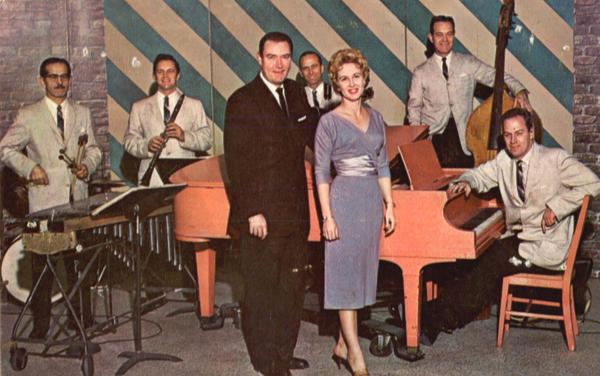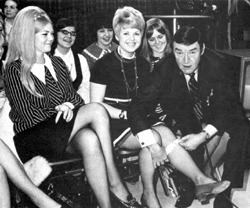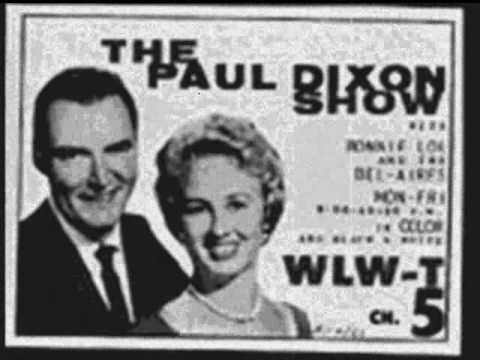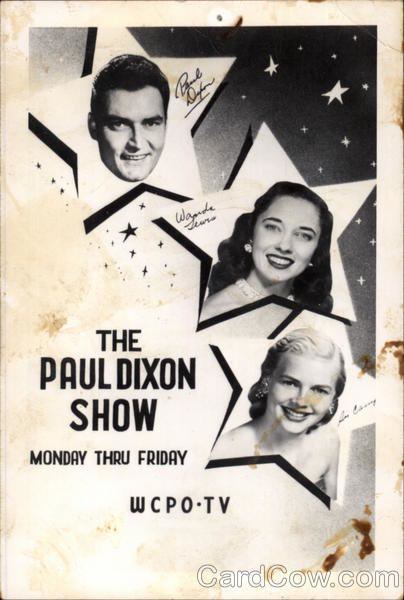Created by John MurphyPaul Dixon Theme music composer Bruce Brownfield Original language(s) English First episode date 29 September 1952 Genre Variety show | Directed by Gordon Waltz Country of origin USA Executive producer(s) John Murphy Final episode date January 1975 Program creators Paul Dixon, John Murphy | |
 | ||
Similar He's the Mayor, The $198 Beauty Show, The Young Marrieds, The Jean Arthur Show, Never Too Young | ||
The Paul Dixon Show was an American television variety program originating in Cincinnati on WLWT Television beginning in 1955 and ending in January 1975, one month after Dixon's death in December 1974. The show began as a 30-minute series expanding to 90 minutes in the 1960s, but the other stations along the Avco Network in nearby Dayton, Columbus and Indianapolis only ran 60 minutes of the show. Pre-recorded episodes were sold to other markets throughout the Midwest.
Contents
- Early beginnings
- This Dumb Show
- Classic moments
- Dixons pet expressions
- The chicken wedding
- Live at the Ohio State Fair
- Sponsors and commercials
- References

The show was originally co-hosted by Bonnie Lou and Marian Spelman, who was later replaced with Colleen Sharp. The house band, originally called The Bel-Aires, was led by pianist Bruce Brownfield.

Early beginnings

Dixon originally hosted a show on rival station WCPO-TV with Dottie Mack and Wanda Lewis called Paul Dixon's Song Shop. The show consisted of Dixon, Mack, and Lewis pantomiming to popular songs of the day, and also featured in-house commercials. Fresh from a career in radio news, Dixon quickly endeared himself to countless viewers for years to come. Song Shop was picked up for a season by ABC in 1951 and by the DuMont Television Network in 1954. For the DuMont show he moved to New York City, but as DuMont began to collapse in 1955, a homesick Dixon returned to Cincinnati a year later and, in a fateful move, hired on at WLWT.

While Dixon was at WCPO, Al Lewis (rapidly gaining fame in his own right as Uncle Al) was in charge of set design and artwork on Dixon's show. After Dixon moved to WLWT, The Paul Dixon Show and The Uncle Al Show would run opposite of each other on weekday mornings.
”This Dumb Show”

By 1955, Dixon was hired on at WLWT to host a daytime show originally geared to housewives, but ultimately appealed to people in all walks of life. Over time Dixon himself would refer to the show as "this dumb show". Every morning the show would start with Paul, using a pair of binoculars (one of what would become many of Dixon’s trademarks), to examine what came to be called “Kneesville”, which consisted of ladies sitting in the front row, all wearing either short skirts or “hot pants”. He would then award the best looking knees by either putting a garter on the lady's leg, or attaching a "knee tickler" to the hem of her skirt.
Some of his other trademarks included, but were not limited to:
Despite the fact that Dixon did basically the same thing every day, viewers would continually watch his show, many of them admitting, often with varying degrees of embarrassment, that they were 'hooked' on Paul Baby.
Guest appearances by celebrities were a rarity at best. Among those who did make appearances were comedian Imogene Coca, actor David McCallum, Senator Robert Kennedy, and even Bob Hope showed up on occasion. Hope was close friends with Dixon and wrote the foreword for Dixon's first book.
Classic moments
Besides in-house commercials, a musical number from the house band, a song each from Colleen and Bonnie (and occasionally a song from Dixon himself, who swore he couldn't sing to save his own life), the show was primarily Paul talking with members of his audience, or reading letters from his viewers, both of which often resulted in hilarious situations:
While Dixon's antics by today’s standards might be construed as chauvinistic or even over-the-top sexist, there was an unspoken understanding between Dixon and his audience (both in-studio and at home) that dictated that he was only going for the laughs and cheers that the antics generated. (Dixon was happily married with two children.)
David Letterman credits Paul Dixon for inspiring his choice of career as talk-show host.
Dixon's pet expressions
(usually said right before grabbing his binoculars to check out Kneesville)
(referring to someone in the audience who had something to say to Dixon. "Gordy" was director Gordon Waltz)
(Dixon sometimes asked this of kids who appeared on the show)
The chicken wedding
At one point a fan had sent Dixon a rubber chicken as a souvenir. He took to calling the chicken Pauline, using it/her as a prop when he did commercials for Kroger, saying "Kroger has a special on chicken", and then invariably tossing it/her over his shoulder. Another fan sent him an additional rubber chicken which Dixon took to calling Harry, who became a "companion" for Pauline. Over time people began to ask if Dixon was going to marry the feathered couple. Dixon was initially against the idea, but as more and more people, including WLWT boss John Murphy, continued to ask when he would perform the "Chicken Wedding", Dixon finally capitulated, and in so doing made television history.
On Tuesday, March 11, 1969, Dixon staged the first ever wedding for two rubber chickens complete with all the trimmings. The wedding itself was broadcast live on the show, and featured then-WLWT news anchor Tom Atkins narrating and Bob Braun as Best Man, with co-hosts Bonnie Lou and Sharp as matrons of honor. Spelman, still at WLWT appearing on other shows, made a guest appearance singing a humorous version of A Bird in a Gilded Cage.
People actually stayed home from work and school to watch the Chicken Wedding live. It went on to become the highest-rated episode in the show's history, and to this day WLWT gets more requests and questions about this particular episode than any other show in the station's 60-plus year history.
Live at the Ohio State Fair
Beginning in 1966 on a request from then-Ohio Governor Jim Rhodes, The Paul Dixon Show (and other local shows on WLWT) began making annual visits to the Ohio State Fair, broadcasting their shows live on location. The following year attendance at the state fair increased by an estimated 1.2 million. The live shows at the fair continued well into the 1970s.
By the end of the 1960s, nearly 600,000 people had been a part of Dixon's studio audience, (by comparison, this figure is nearly twice the 2006 population of Cincinnati proper), and Dixon had given away upwards of 3,000 Osherwicz Kosher Salamis. At the show's peak there was a two-year waiting list for tickets.
Sponsors and commercials
Most of Dixon’s show consisted of live commercials, performed mainly by Dixon himself, but also by one of the ladies on occasion. Dixon shunned the use of scripts when doing commercials, much to the perpetual delight of his audience. In the tradition of Ruth Lyons, any product plugged by Dixon became the product to use.
